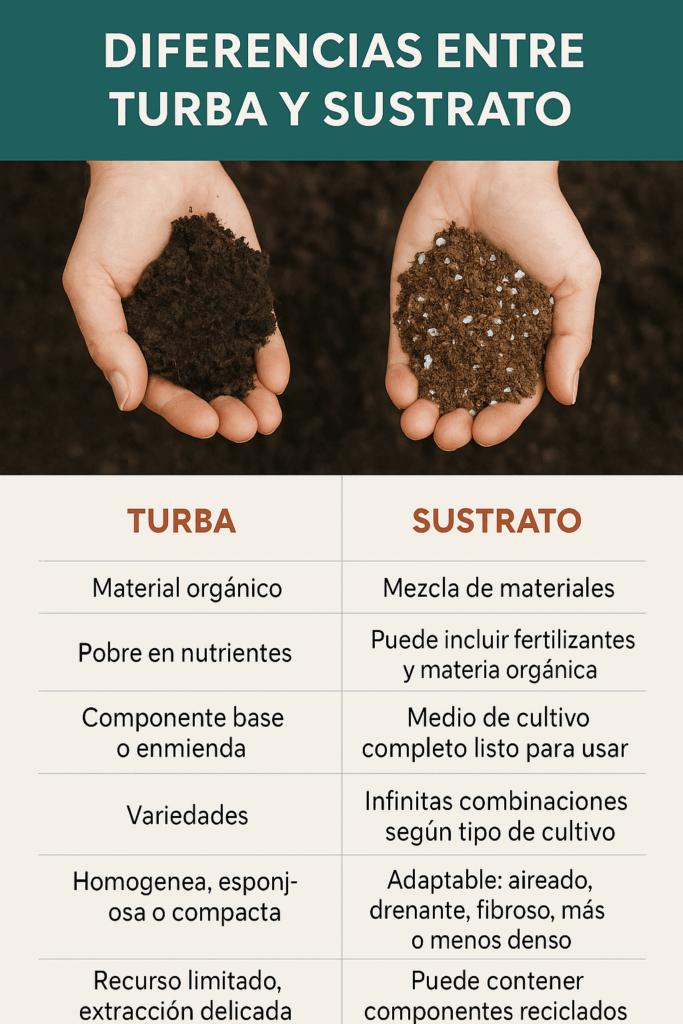Peat or substrate? Understand the differences to grow better.
When starting out in the world of cultivation, it is common to confuse terms that seem synonymous, but are not. One of the most common mistakes is to think that peat and substratum They're the same. Although they're related, peat and substrate have key differences that are helpful to understand in order to choose the right growing medium for your needs.
At Murgiplast, as specialists in solutions for nurseries, horticulture, and technical crops, we explain in detail what peat is, what a substrate is, and when to use one or the other.
What is peat?
The peat is a source material vegetable It forms naturally in swampy areas, where the decomposition of plant remains occurs very slowly due to a lack of oxygen. This process can take thousands of years, which is why peat is considered a short-term non-renewable resource.
Types of peat
Blonde peat:
Originating from the uppermost layers of peat bogs, blond peat is characterized by its light color, its fibrous and spongy texture, and its highly acidic pH (generally between 3.5 and 4.5). It has a very high water retention capacity and excellent aeration, making it ideal for seedlings, cuttings, acid-loving plants, and as a base for light potting mixes.
Black peat:
This peat is extracted from the deepest and oldest layers, where the plant matter is most decomposed. It has a dark color, a more compact texture, and a less acidic pH (between 5 and 6.5). It is denser and heavier than blond peat, which is why it is commonly used to improve soil structure, provide stabilized organic matter, or as part of heavier mixes in professional substrates.
Advantages of peat
- Great water retention capacity.
- Good aeration, especially the blonde one.
- Structural stability.
- Low electrical conductivity (ideal for sensitive plants).
Disadvantages of peat
- Ecological impact due to its extraction.
- Low fertility alone: contains no nutrients.
- It is not recommended to use it alone as the sole culture medium.
What is a substrate?
A substratum is a artificially prepared mixture to serve as a growing medium. Unlike peat, which is a natural component, the substrate is formulated by combining several materials to meet all the plant's needs.
What can a substrate contain?
- Blonde and/or black peat.
- Coconut fiber: aeration and water retention capacity.
- Perlite: improves oxygenation.
- Vermiculite: water and nutrient retention.
- Vegetable compost or humus: contribution of organic matter and nutrients.
- Fertilizers: mineral or organic, for initial fertilization.
Each substrate is designed for a specific use: seedbeds, ornamental plants, urban gardens, professional pot cultivation, etc.
Advantages of the substrate
- This ready to use.
- Offers a optimal balance between water retention, aeration and nutrients.
- It's more versatile: There are formulations for every type of plant and stage of cultivation.
- Could be sterilized, reducing the risk of disease.
Disadvantages of the substrate
- Its price may be higher than the individual components.
- Some generic substrates may have variable qualities.
- Over time, they can compact and lose effectiveness if they are not replaced or mixed with new materials.
Key differences between peat and substrate
| Feature | Peat | Substratum |
| Origin | Natural material | Artificial mixture of several components |
| Nutrients | Poor in nutrients | May include fertilizers and rich organic matter |
| Main use | Base component or amendment | Complete culture medium ready to use |
| Varieties | Blonde and black | Infinite combinations depending on the type of crop |
| Texture | Homogeneous (spongy or compact) | Adaptable: aerated, draining, fibrous, more or less dense |
| Sustainability | Limited resource, delicate extraction | May contain recycled or renewable components |
| Price | Generally cheaper per kilo | More expensive, but more complete and functional |
Can they be used together?
Of course! In fact, Peat is one of the main components of many commercial substratesIt is often mixed with other materials to compensate for its deficiencies (such as lack of nutrients or drainage).
For example:
- A substrate for seedbeds It can have 60–70% of blond peat, 20% of perlite and a mild fertilizer.
- A substrate for potted vegetables may include black peat, vegetable compost, coconut fiber and slow-release fertilizer.
Which one should I choose?
It depends on the use you are going to give it:
- Are formulating your own substrateThen you can buy peat as a base and mix it with other elements.
- Do you want a quick and balanced solution? Then choose a quality commercial substrate, already prepared.
- Do you grow in a professional volume? Assess consistency, water retention, and nutritional needs based on the growing cycle.
At Murgiplast we help you choose
At Murgiplast we not only manufacture Professional pots for nurseries, grow shops and technical crops, we also distribute professional quality substrates and peats, selected for their performance, stability and consistency.
If you need blond peat for specific mixes, or ready-to-use substrates adapted to different growing stages, contact us! Our technical team, familiar with the differences between peat and substrate, can help you choose the best option for each plant.

